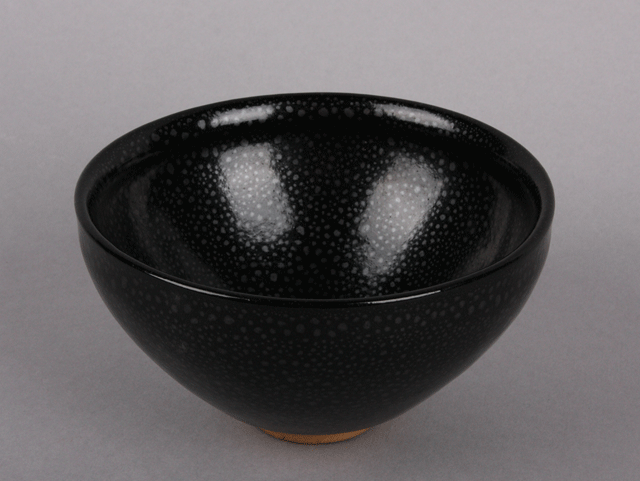
2012.91.90, "oil spot" tea bowl. Song Dynasty (960–1279 CE)
Eason Eige Collection; photo by B. Bernard
Like Jun Ware, Tian Mu ware (天目) is an example of the mastery of the ancient Chinese potters. To help provide an appreciation of the "oil spot" effect seen on the bowl shown below, on this page we provide more technical detail than usual.

2012.91.90, "oil spot" tea bowl. Song Dynasty (960–1279 CE)
Eason Eige Collection; photo by B. Bernard
In the mid-900s, potters in northern Fujian began making black-glazed stoneware, Tan Mu (天目). The new black pottery was highly successful and was widely imitated in northern China during the Song and Jin dynasties. The example shown above is one of the later copies. For a second view of the bowl, including its unglazed ring foot, click here. Tian Mu ware was widely imitated in Japan, and in the West the ware is better known by Japanese-derived names, tenmoku, temmoku, and temoku.
The black glaze is derived from iron oxide. The bowl was fired at a high enough temperature (more than 2000 degrees Farenheit) to cause red iron oxide (Fe2O3) to reduce to black iron oxide (FeO). As oxygen was released from the red iron oxide, it bubbled to the surface of the glaze. The bubbles dragged magnetite (Fe3O4, also produced during the reduction process) to the surface of the glaze, and the magnetite collected to form the spots. In one variation, known as hare's fur glaze, the spots of material flow down the surface of the bowl, creating long streaks.
While the bowl's black background and silvery highlights make it a
masterpiece of the potter's art, the bowl's dark surface served a specific
purpose, as we explain
here.
To learn more: Chinese Glazes by Nigel Wood.
See source code for copyright information. Page last revised on January 29, 2016. Please report problems to toh@unm.edu